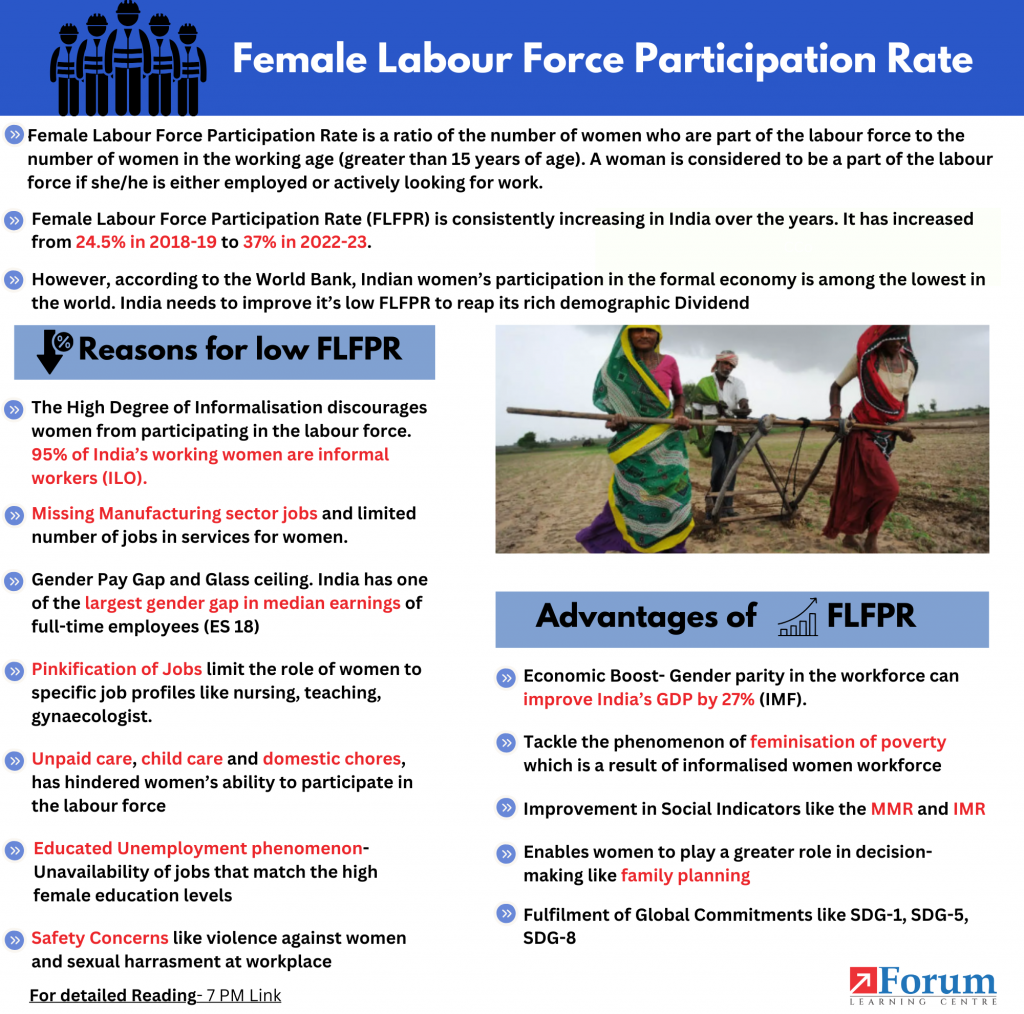
India’s Low Female Labour Force Participation rate is a big threat to India’s Demographic Dividend. India still has not cracked the code of getting women to work in time. Any further delay in improving the female labour force participation in productive sector, will be detrimental to India’s dream of becoming a developed nation by 2047. Female Labour Force Participation Rate

What is Female Labour Force Participation Rate (FLFPR)?
Female Labour Force Participation Rate is a ratio of the number of women who are part of the labour force to the number of women in the working age (greater than 15 years of age). A woman is considered to be a part of the labour force if she/he is either employed or actively looking for work.
FLFPR trend in India
1. Female Labour Force Participation Rate (FLFPR) is consistently increasing in India. However, it is still very less compared to the developed nations.
| 2022-23 | 37% |
| 2021-22 | 32.8% |
| 2020-21 | 32.5% |
| 2019-20 | 30% |
| 2018-19 | 24.5% |
2. The simple average of the FLFPR of the five southern Indian states (Tamil Nadu, Karnataka, Telangana, Andhra Pradesh, Kerala) is 13% lower than the five northern states of Himachal Pradesh, Rajasthan, Chhattisgarh, Madhya Pradesh and Jharkhand. This defies the conventional belief that southern states, with high literacy and women empowerment indices, will have high FLFPR.
3. There are only four states (Assam, Bihar, Haryana and Delhi) with an FLFPR of less than 25%. Delhi has the lowest at 14.8%.
4. According to the World Bank, Indian women’s participation in the formal economy is among the lowest in the world. Only some parts of the Arab world perform worse than India in terms of FLFPR.
What are the reasons for low Female Labour Force Participation rate in India?
1. High Degree of Informalisation– According to a 2018 study by the International Labour Organisation (ILO), more than 95% of India’s working women are informal workers. The absence of social security net in the informal sector discourages women from participating in the labour force.
2. Missing manufacturing- Lack of alternative employment opportunities in manufacturing and the limited number of jobs in services for women, has also suppressed FLFPR in India.
3. Gender Pay Gap and Glass ceiling- According to the Economic Survey 2018, India has one of the largest gender gap in median earnings of full-time employees. Such discriminatory practices at workplace adversely affects FLFPR.
4. Pink Jobs- The societal notions about ‘gendered occupations’ limit the role of women to specific job profiles like nursing, teaching, gynaecologist etc. There are tangible and intangible barriers to entry of women in multiple professions like heavy engineering, law enforcement, armed forces etc.
5. Cultural practices- Unpaid care, child care and domestic chores, has hindered women’s ability to participate in the labour force. In a patriarchal society, many women are not allowed to work after marriage.
6. Increase in Household Income- The rise in household incomes in both the rural and urban areas has provided women the choice to not take up jobs.
7. Safety Concerns- High incidents of violence against women discourages women to work in the night like their male counterparts. Further, instances of sexual harassment at workplace induces women to opt out of labour force.
8. Educated Unemployment- Women are going for higher education, as seen in Gross Enrolment Ratio (GER) of secondary education. The lack of availability of jobs that match the high female education levels also contributes to the low FLFPR.
9. Legally sanctioned restrictions- Many States continue to restrict women’s participation in hazardous jobs in factories and commercial establishments. For ex- women are not allowed to work on stone-cutting machines, shop floor of boilers, etc.
10. Political Vacuum- The current Lok Sabha has only 14.4% women, despite women constituting around 50% of Indian population. The lack of gender perspectives inhibits formulation of a comprehensive policy that encourages women participation in economic activities.
What is the significance of enhancing Female Labour Force Participation?
1. Economic Boost- According to the IMF, gender parity in the workforce can improve India’s GDP by 27%.
2. Tackling poverty- It helps to tackle the phenomenon of feminisation of poverty, which is a result of highly informalised work performed by women.
3. Improvement in Social Indicators- Encouraging more women to enter the formal workforce will improve indicators like Infant Mortality Rate (IMR), Maternal Mortality Rate (MMR).
4. Self Confidence and Dignity- Financial independence enables women to play a greater role in decision-making like family planning.
5. Global Commitments- Improving FLFPR is related to achievements of SDG 1 (No Poverty), SDG 5 (Gender Equality), SDG 8 (Decent Work and Economic Growth) and SDG 10 (Reduced inequalities).
What steps have been taken by the Government to enhance Female Labour Force Participation?
| Maternity Benefit (Amendment) Act, 2017 | The Act more than doubled the duration of paid maternity leave for women employees to 26 weeks. It proposed an option to work from home after this period, on mutual agreement with the employer. It made crèche facilities mandatory for establishments employing 50 or more women. |
| Anganwadi centres under the ICDS | They provide maternal and child nutritional security, a clean and safe environment, and early childhood education. Thus, they facilitate the ability of women to re-enter work post-childbirth. |
| National Food Security Act (NFSA), 2013 | Apart from providing affordable food, it entitles pregnant and lactating mothers to a cash transfer of at least INR 6,000. This is done to break the compulsion for early returning to work. |
| Stand up India | The scheme facilitates bank loans for setting up a new enterprise in manufacturing, services, agri-allied activities, or the trading sector by SC/ST/Women entrepreneurs. It provides bank loans between INR 10 lakh and up to 1 crore. |
| The Sexual Harassment of Women at Workplace Act, 2013 | It is a legislative act in India that seeks to protect women from sexual harassment at their place of work |
Conclusion and Way Forward
1. Child Care Subsidies- Child-care subsidies should be provided to free up mothers’ time to enter the labour force, which would have significant implications in increasing female employment.
2. Comprehensive approach to improve women labour force participation- A comprehensive approach aimed at improving skill development, access to child care, maternity protection, and provision of safe and accessible transport, is needed.
3. Removal of the legally sanctioned legislation- States should review legislations like the Factory Act, Shops and Establishment Act etc. and liberalise the restrictions on women. The best practices from well performing States can be adopted across all States. For ex- Andhra Pradesh and Telangana are the only two states that allow women to work in all processes in all establishments.
4. Creation of Self Help Groups- The focus should be on creation of more Self Help Groups. They are of immense reliance and drastically enhance women participation as seen in case of Kudumbashree model of Kerala.
5. Use of innovative solutions to enhance female retention in industries- Public crèches can be operated at worksite clusters such as near industrial areas, markets, dense low-income residential areas, and labour nakas. This model has been tested successfully by Self-Employed Women’s Association (SEWA) Sangini in some Indian cities.
6. Accounting for Care economy- We need to account for care economy in the GDP calculations.
Conclusion
There is a need to take multiple steps to augment the female labour force participation in India in order to realise the numerous social and economic benefits that accrue from greater presence of women in the workforce. It can help India move from women-centric development to women-led development.
| Read More- Livemint UPSC Syllabus- GS 3 Inclusive Growth, GS 1 Women empowerment, GS 2 Vulnerable sections of the society |
Discover more from Free UPSC IAS Preparation Syllabus and Materials For Aspirants
Subscribe to get the latest posts sent to your email.







